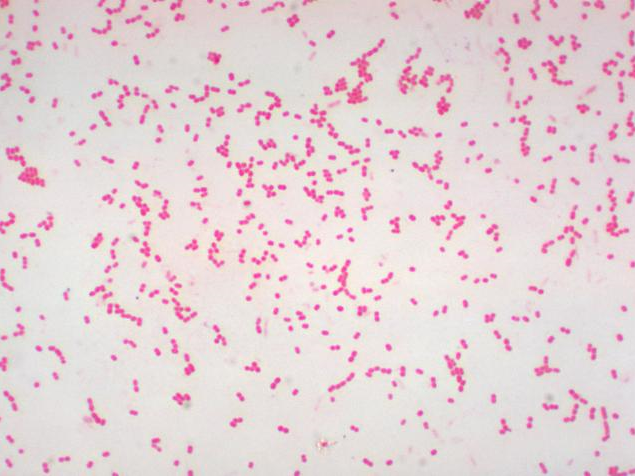TSRL, Inc., under an agreement with Purdue Research Foundation, is developing antimicrobials that penetrate cells, target intracellular pathogens and break down established biofilms.
Cell-penetrating peptides for treatment of complicated bacterial infection
Unmet Need: Hospital-Acquired Pneumonia
Conjugate composed of kanamycin and P14LRR [6]
Over 600,000 hospital-acquired infections (HAIs) occur in the United States every year. One in ten patients die of infection during hospitalization, making HAIs the sixth leading cause of death behind diabetes (76,488 deaths in 2014) [1] [2] [3]. Out of all nosocomial infections, hospital-acquired pneumonia (HAP) is the second most common, accounting for 15% of all HAIs [4]. The largest risk factor for developing HAP is intubation and mechanical ventilation, directly correlating to patient condition and length of stay. In fact, ventilator-associated pneumonia--a sub-category of HAP--is the most common nosocomial infection in critically ill patients, affecting nearly 90% of ventilated patients in the intensive care unit [4]. Pathogenic Gram(-) and Gram(+) bacteria are the primary causes of HAP and vary between institutions. Thus, an effective, broad-spectrum therapeutic is urgently needed.
According to American Thoracic Society and Infectious Disease Society of America evidenced-based guidelines, empiric treatment should be provided immediately to critically ill patients. Antimicrobial agents the patient has already received or that have a high likelihood of contributing to local resistance should not be used. With the emergence of multidrug-resistance (MDR) in several classes of widely-used antibiotics, such as carbapenems, polymyxins, and beta-lactams, a new mechanism of action is needed, especially for empiric treatment. Cell-penetrating peptides open up a new treatment modality in the fight against MDR bacteria.
Unmet Need: Skin & Soft Tissue Infections
Gram(+) bacteria such as Staphylococcus, Streptococcus, and Enterococcus are major human pathogens responsible for a large number of life-threatening infections. Antibiotic resistant strains such as methicillin resistant Staphylococcus aureus (MRSA) and vancomycin resistant Enterococcus (VRE) are widespread and limit the effectiveness of available antibiotics. CDC statistics show that there are 80,461 severe infections and 11,285 deaths due to MRSA per year in the USA. Similarly, there are 20,000 infections and 1300 deaths per year due to VRE.
Solution & Benefits
Our collaborators have developed a lead series of potent, cell-penetrating aminoglycoside peptide conjugates, based on cationic, amphiphilic polyproline helices (CAPHs), for treatment of HAP [5] [6]. The CAPHs have been engineered to maximize broad-spectrum activity against clinically relevant Gram(-) and Gram(+) pathogens and to minimize toxicity to human cells. They have been shown to target intracellular pathogens, to break down established biofilms of Category B and C pathogens, and to exhibit unique characteristics that differentiate them from other antimicrobial peptides in past clinical development. For example, in vitro and in vivo data reveals low levels of hemolysis of erythrocytes and limited toxicity to mammalian cells. When coupled to antibacterial therapeutics such as kanamycin, CAPHs exhibited many advantageous qualities, including:
- broad spectrum activity,
- potent activity against stationary phase bacteria,
- potent activity against established biofilms,
- ability to kill intracellular and persistent pathogens,
- ability to reduce pro-inflammatory cytokines.
Last, the prevalence of unnatural proline-rich amino acid residues has been shown to reduce proteolysis, potentially allowing for greater metabolic stability in vivo and opening a development path for clinically relevant IV and inhalation formulations.
Research Status
In 2017, the TSRL-Purdue team was awarded a two-year, $600,000 Phase I Small Business Technology Transfer (STTR) grant (#R41AI132102) from the National Institute of Allergy & Infectious Diseases (NIAID) of the National Institute of Health (NIH). Researchers at Purdue University are building on their proof-of-concept studies with the aminoglycoside kanamycin. The team not only demonstrated a >128–fold improvement of in vitro efficacy against previously resistant strains to kanamycin, but have shown a dramatically reduced development of resistance, likely from the novel MOA of the conjugates and cell penetrating peptide. In conjunction with Purdue researchers, we are pursuing the development of an IV and inhalation formulation (i.e. nebulizer) of aminoglycoside-CAPH conjucattees administered as a monotherapy to HAP patients in nosocomial settings.
Market Need: Treatments for Gram Negative Infections
Overview & Treatment Options
Overview: The emergence of multi-drug-resistant (i.e. cephalosporin-resistant) gram-negative bacterial infections like N. gonorrhoeae, E. coli, and P. aeruginosa have created a substantial need for the development of new therapies. As of 2010, ceftriaxone appears to be one of the few effective antibiotics left for treating multi-drug resistant infections with IV the only approved route of administration. Likewise, N. gonorrhoeae causes gonorrhea, the second most commonly reported sexually transmitted disease and a differential diagnosis to urinary tract infections. According to the CDC, an estimated 820,000 cases of the disease are contracted each year in the United States, of which 30% are resistant to existing antibiotics [7]. The disease can cause severe reproductive complications, including discharge and inflammation at the urethra, cervix, pharynx or rectum. Finally, P. aeruginosa causes significant nosocomial infections such as ventilator-associated pneumonia and various sepsis syndromes.
Regulatory Benefits & Market Potential
Potential Regulatory Benefits: Qualified Infectious Disease Product Exclusivity, Fast-Track, Accelerated Review.
Market: Treatment for gram negative infections is dominated by generic/branded 3rd generation cephalosporins like ceftriaxone, with newer approved 5th generation ceftolozane recently taking market share. Using sales estimates for these recent approvals as an analogue, the global market for an effective antibiotic for gram negative indications is expected to be $740 million per year. First in class antibacterials that can be administered in a single dose, that are safe and effective against drug-resistant gram-negative strains--including strains that are resistant to cephalosporins--with an oral step-down therapy would fit this criteria.
References:
[1] Centers for Disease Control and Prevention, "HAI Data and Statistics," 2 March 2016. [Online]. Available: https://www.cdc.gov/hai/surveillance/. [Accessed 9 November 2016].
[2] S. S. Magill, J. R. Edwards, M. Stat, W. Bamberg and G. Zintars, "Multistate Point-Prevalence Survey of Health Care–Associated Infections," New England Journal of Medicine, vol. 370, pp. 1198-1208, 2014.
[3] Centers for Disease Control and Prevention, "Leading Causes of Death," 7 Oct 2015. [Online]. Available: http://www.cdc.gov/nchs/fastats/leading-causes-of-death.htm. [Accessed 9 November 2016].
[4] R. Tedja and S. Gordon, "Hospital–Acquired, Health Care–Associated, and Ventilator–Associated Pneumonia," November 2013. [Online]. Available: http://www.clevelandclinicmeded.com/medicalpubs/diseasemanagement/infectious-disease/health-care-associated-pneumonia/. [Accessed 8 November 2016].
[5] J. Kuriakose, V. Hernandez-Gordillo, M. Nepal, A. Brezden, V. Pozzi and M. Seleem, "Targeting intracellular pathogenic bacteria with unnatural proline-rich peptides: coupling antibacterial activity with macrophage penetration," Angewandte Chemie, vol. 52, no. 37, pp. 9664-7, 2013.
[6] A. Brezden, A. Mohamed, M. Nepal, M. Harwood, J. Kuriakose, M. Seleem and J. Chmielewski, "Dual Targeting of Intracellular Pathogenic Bacteria with a Cleavable Conjugate of Kanamycin and an Antibacterial Cell-Penetrating Peptide," J Am Chem Soc, vol. 138, pp. 10945-10949, 2916.
[7] Centers for Disease Control and Prevention, "Gonorrhea - CDC Fact Sheet (Detailed Version)," 2015.


![Conjugate composed of kanamycin and P14LRR [6]](https://images.squarespace-cdn.com/content/v1/5538228fe4b02fdbd28befb3/1495744962711-FQ8H9FQIX5K7WH4SH166/Credit%3A+Jean+Chmielewski)

